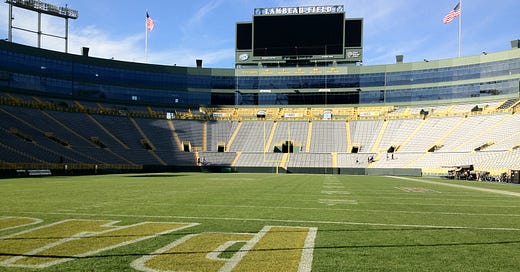There’s an art and a science to the NFL Draft. A team’s strategy shifts from year to year based on their current roster, draft position, and the make-up of a given year’s class. It shifts again on Draft Day(s) depending on the picks made and players available.
Removing the quarterback position (which is its own separate animal), drafting for talent is generally a better way to go than drafting for need, particularly in the early rounds.
Nothing Wrong With Too Much Talent
So you’ve already got two good edge rushers? Why not draft a third if he’s the best player available? Do pass rushers never get injured? Would using a rotation to keep them fresh for 60 minutes be a bad thing? Can you do something with 3 edge rushers that creates an advantage over other teams? Maybe you move one inside and develop a NASCAR package for obvious passing situations like the 2011 Giants did on their way to a second Super Bowl title in 4-years?
Take advantage of our 50% discount on monthly and yearly subscriptions!
Do you think having multiple talented players at the same position won’t create healthy competition and bring out the best in each of them? Do you think the 4 members of the Steel Curtain D-Line didn’t push each other?
Another plus of this approach is the ability to manipulate the roster better due to the excess talent. Maybe you deal one of those pass rushers the next year for a player who fits a need, both positionally and from a talent standpoint.
Or perhaps the excess talent just gives a team leverage in negotiations. Maybe they can allow one player to walk when free agency comes around. The position group can still be dangerous (but less expensive) with the two remaining great pass rushers.
Also keep in mind that being dominant at one position group can impact other areas of the team. Your secondary doesn’t need to have quite the same talent if they’re playing behind a great pass rush, for instance.
Either way, you can’t go wrong by drafting good football players. If the talent available at the time of a team’s selection matches up to a need, that’s absolute perfection. If it doesn’t, then turn a strong position group into a dominant one that helps drive the team’s identity.
And that brings us to the Browns and Giants. They own the 2nd and 3rd overall picks respectively and both are in need of a long-term solution at quarterback.
But this isn’t the year to use that type of draft capital on the quarterback position. Behind Cam Ward is nothing but question marks. Both teams would probably be better off taking dynamic players like Travis Hunter or Abdul Carter.
And both the Browns and Giants added two quarterbacks capable of starting during the offseason. These were seemingly moves to make them less desperate during the draft.
If a QB they like falls to them early in the second round (or they can trade up to the back of the first round to get the 5th-year option), that’s great. If they can’t, at least they don’t have to reach for a QB based on 2025 needs.
Addressing Needs
All that said, if a team is hell-bent on prioritizing their current needs above talent, then they should prioritize the biggest need and bludgeon it with picks (aside from the QB position).
Too often, teams have multiple holes that they try to fill one player at a time. The hit rate on draft picks isn’t great, even for the most competent teams, and the unexpected always seems to happen. The player you love underperforms. The player you don’t expect much from can become a 10-year starter. Someone is going to get injured.
The team I have most in mind here is the New England Patriots. They have to prioritize protecting Drake Maye. They need help up front, now and in the future, and should be thinking offensive line early and often.
So why not draft 3 O-linemen in the first 3 rounds (where they currently have 4 picks)? One of them has got to hit, right…right?!
Take a page out of the 1981 49ers’ book. That team was entering the 3rd year of Joe Montana’s career and appeared to have promise on offense under Bill Walsh. But their defense was atrocious. Specifically, their secondary was a liability.
In 1980, they finished 26th (of 28 teams) in points allowed, 27th in passing yards and TDs, and dead last in passer rating, completion percentage, and yards per attempt allowed.
So here’s what they did in the ‘81 draft:
The 49ers took 3 defensive backs who would anchor this side of the ball for most of the 80’s. And overnight, the defense changed.
In 1981, San Francisco ranked 2nd in points allowed, 3rd in passing yards allowed, 6th in passing TDs allowed, 4th in passer rating against, 7th in completion percentage against, and 3rd in yards per attempt allowed.
That year, they would go on to win their first of four Super Bowls during the eighties.
I understand that this is all a lot easier said than done. Again, there’s an art and a science to it that goes beyond what was covered in this post. It will be interesting to see the approaches of all 32 NFL teams, as it is every year.
Thursday Night can’t come soon enough.





I've always been a supporter of best player available. Unless their is a top tier prospect at a position of need. I like tackles and o-linemen with versatility, edge rushers, and corners. Most important positions outside of quarterback. Can't go wrong with premium players even if depth isn't a concern.